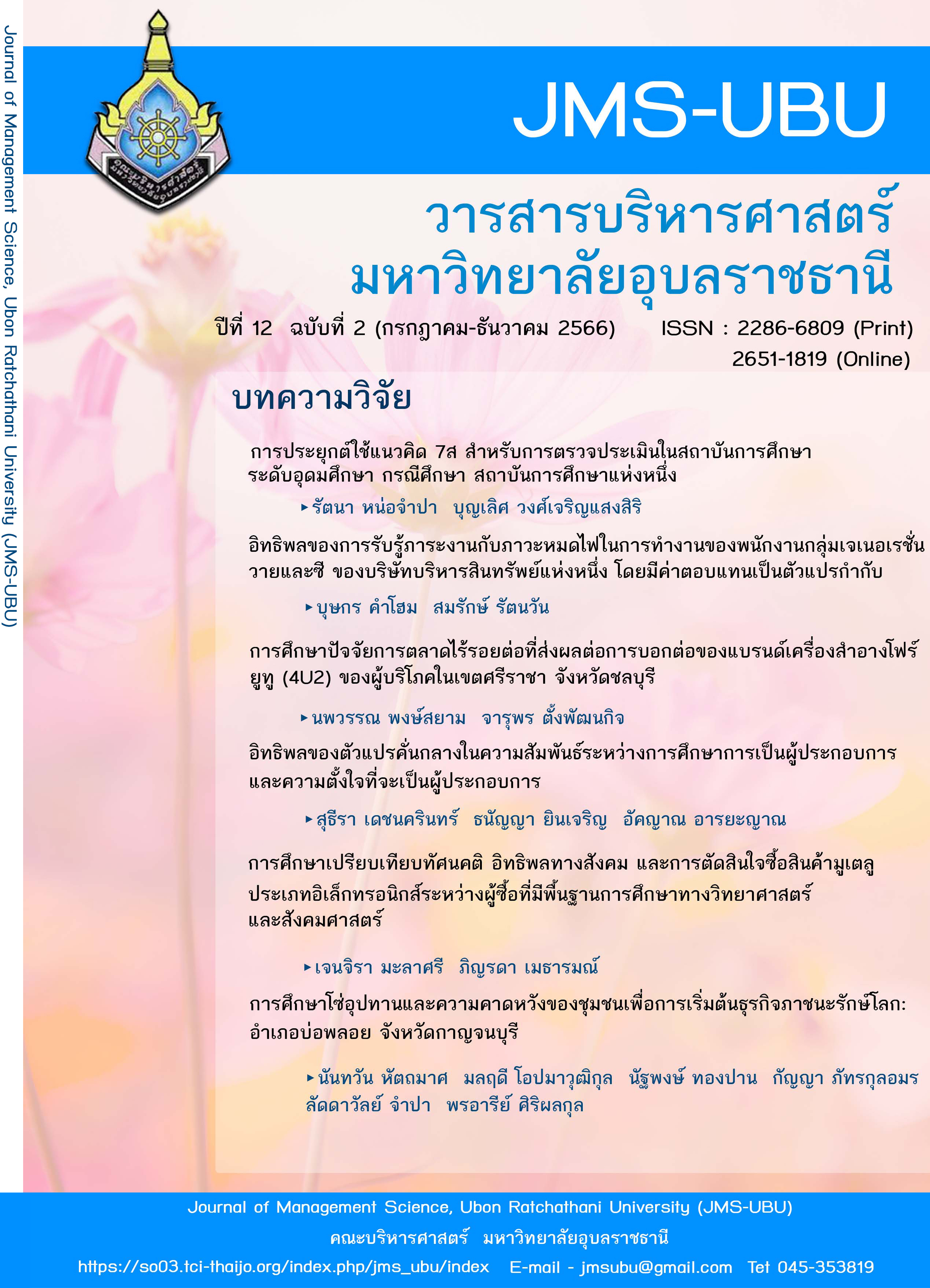การประยุกต์ใช้แนวคิด 7ส สำหรับการตรวจประเมินในสถาบันการศึกษาระดับอุดมศึกษา กรณีศึกษา สถาบันการศึกษาแห่งหนึ่ง
Main Article Content
บทคัดย่อ
การวิจัยนี้มีวัตถุประสงค์เพื่อปรับปรุงมาตรฐานแบบตรวจประเมินกิจกรรม 7ส ให้เป็นไปตามหลักเกณฑ์มาตรฐาน 7ส ในสถาบันการศึกษา และให้เหมาะสมกับผู้ใช้งานแต่ละกลุ่ม โดยการประยุกต์ใช้ระเบียบวิธีวิจัยเชิงคุณภาพ แบบการวิจัยกรณีศึกษา (Case Study Research) เพื่อให้ทราบถึงมุมมองที่มีต่อหัวข้อการตรวจประเมินที่มีอยู่ทั้งในด้านความสอดคล้องและความจำเป็นของเกณฑ์การตรวจประเมินที่ใช้อยู่ต่อการปฏิบัติงานจริง และประโยชน์ของการตรวจประเมินต่อการปฏิบัติงาน เครื่องมือที่ใช้ในการวิจัย คือ แบบสัมภาษณ์เชิงลึกแบบกึ่งโครงสร้าง โดยกลุ่มผู้ให้ข้อมูลหลักประกอบด้วยอาจารย์หรือผู้บริหารสายวิชาการ จำนวน 10 คน และผู้บริหารสายสำนักงานจำนวน 10 คน ซึ่งพิจารณาเลือกจากผู้ที่มีประสบการณ์ถูกตรวจประเมินในพื้นที่อย่างน้อย 5 ครั้ง ประกอบกับเกณฑ์การตรวจประเมิน 7ส ที่ใช้งานอยู่จริง เพื่อใช้ผลการศึกษาเป็นแนวทางการปรับปรุงมาตรฐานแบบตรวจประเมินกิจกรรม 7ส และเปรียบเทียบความสอดคล้องของมาตรฐาน 7ส กับแบบการตรวจประเมินกิจกรรม 7ส ส่วนของพื้นที่สำนักงาน
ผลการวิจัยประกอบด้วย ข้อสรุปความคิดเห็นเกี่ยวกับหัวข้อตรวจประเมินกิจกรรม 7ส พื้นที่สำนักงานทั้ง 12 ข้อ จากการเปรียบเทียบเกณฑ์แบบตรวจประเมินพื้นที่กับภาวะการปฏิบัติงานจริงของสำนักงาน พบว่าการปรับปรุงมาตรฐานแบบตรวจประเมินให้มีความเหมาะสมสอดคล้องกับผู้ใช้งานแต่ละกลุ่ม โดยการปรับเกณฑ์ให้สอดคล้องกับกลุ่มผู้ใช้งานสำหรับบุคลากร และสำหรับอาจารย์ และปรับหัวข้อที่มีความคล้ายกันเพื่อให้การตรวจไม่ซ้ำซ้อน โดยการรวมหัวข้อการตรวจเข้าด้วยกัน ทำให้ข้อแบบประเมินลดลงจาก 12 หัวข้อ เหลือ 8 หัวข้อสำหรับบุคลากร และเหลือ 9 หัวข้อสำหรับอาจารย์ ทั้งนี้ เพื่อให้การตรวจประเมินเป็นมาตรฐาน ต้องให้ความรู้ถึงเกณฑ์ตรวจประเมินในแต่ละหัวข้อว่ามีวัตถุประสงค์เพื่ออะไรจึงมีการเพิ่มการระบุวัตถุประสงค์ของการตรวจในแต่ละหัวข้อโดยจัดทำรายละเอียดเกณฑ์การตรวจประเมินกิจกรรม 7ส ใหม่ขึ้น
Downloads
Article Details

อนุญาตภายใต้เงื่อนไข Creative Commons Attribution-NonCommercial-NoDerivatives 4.0 International License.
เอกสารอ้างอิง
กนกกร กมลเพ็ชร, นราพงศ์ เกิดบัวเพชร, ธนัช บุญจันทร์, และ คณะกรรมการ 5ส. (2559). อยู่เป็นสุข สนุกกับ "5ส". PULINET Journal, 4(2), 332-343.
กองแผนและพัฒนา. (2557). คู่มือกิจกรรม 7ส มหาวิทยาลัยหัวเฉียวเฉลิมพระเกียรติ (ฉบับปรับปรุง ครั้งที่ 1). สืบค้นเมื่อ 18 มิถุนายน 2564, จาก http://www.lib.hcu.ac.th/images/filedownload/7clean2558-2.pdf
กองยกระดับคุณภาพการจัดการศึกษาระดับอุดมศึกษา. (2564). เกณฑ์คุณภาพการศึกษาเพื่อการดําเนินการที่เป็นเลิศ ฉบับปี 2563-2566. กรุงเทพฯ: บริษัท อมรินทร์พริ้นติ้งแอดน์พับลิชชิ่ง จำกัด (มหาชน).
คณะอุตสาหกรรมเกษตร มหาวิทยาลัยสงขลานครินทร์. (2564). 5ส. สืบค้นเมื่อ 16 มิถุนายน 2564, จาก http://agrodatabase.psu.ac.th/5s/
นิพนธ์ บัวแก้ว. (2551). รู้จักระบบการผลิตแบบลีน (Lean manufacturing system). กรุงเทพฯ: สมาคมส่งเสริมเทคโนโลยี(ไทย-ญี่ปุ่น).
มหาวิทยาลัยเทคโนโลยีราชมงคลสุวรรณภูมิ. (2564). รายงานผลการตรวจประเมินกิจกรรม 5 ส+3. สืบค้นเมื่อ 16 มิถุนายน 2564, จาก http://qa.rmutsb.ac.th/webqa/manual-5s-plus3.php
มหาวิทยาลัยเทคโนโลยีราชมงคลอีสาน วิทยาเขตสุรินทร์. (ม.ป.ป.). RMUTI คู่มือการดำเนินงานกิจกรรม 7ส วิทยาเขตสุรินทร์. สืบค้นเมื่อ 18 มิถุนายน 2564 , จาก https://af.surin.rmuti.ac.th/surin/direct/QA/pdf/7s.pdf
มหาวิทยาลัยวลัยลักษณ์ (2564). 5ส มวล. สืบค้นเมื่อ 16 มิถุนายน 2564, จาก https://5s.wu.ac.th/สำนักคุณภาพการศึกษา
วนิดา สิงห์น้อย. (2558). การบริหารจัดการสำนักงานด้วย 5ส แล้วชีวิตคุณจะง่ายขึ้น. นิตยสาร สสวท., 43(195). 43-45.
สร ปิ่นอักษรสกุล. (2553). 5ส ดีอย่างไร ทำไมจึงต้องทำ. สืบค้นเมื่อ 20 มิถุนายน 2564 จาก https://www.tpa.or.th/publisher/pdfFileDownloadS/FQ148_p45-50.pdf
สำนักคุณภาพการศึกษา. (ม.ป.ป.). คู่มือกิจกรรม 5ส + 3. พระนครศรีอยุธยา; มหาวิทยาลัยเทคโนโลยีราชมงคลสุวรรณภูมิ.
Ashokkumar, J. (2021). Implementation of 5S model from corporate to educational institutions. International Journal of Science and Research, 10(10), 1247-1250.
ASQ.(2022). The 7 basic quality tools for process improvement. Retrieved June 15, 2022, from https://asq.org/quality-resources/seven-basic-quality-tools
Attri, R., Singh, B., & Mehra, S.(2017). Analysis of interaction among the barriers to 5S implementation using interpretive structural modeling approach. Benchmarking: An International Journal, 24 (7), 1834-1853.
Carrera, J. F., Olmo, A. A., Cuadrado, M. R., Escudero, M. d., Escudero, M. M. E., & Cuadrado, L. R. (2021). From lean 5S to 7S methodology implementing corporate social responsibility concept. Sustainability, 13. DOI:https://doi.org/10.3390/su131910810
Chang, C. Y., & Chen, C. Y. (2014).Prioritisation on 5S activities for a semiconductor wafer fabrication: an empirical study. International Journal of Quality & Reliability Management, 31(4), 380-394.
Conte, S. P. (2020) The effectiveness of implementing 5S (sort, strengthen, shine, standardize, sustain) to make ict classroom of grade 10 students at holy spirit national high school conducive to learning. European Journal of Humanities and Educational Advancements (EJHEA), 1(4), 48-54.
European Court of Auditors. (2022). Communication in audit. Retrieved July 10, 2022, from https://methodology.eca.europa.eu/aware/GAP/Pages/Communication-in-audit.aspx#:~:text=Establishing%20effective%20communication%20throughout%20the,satisfaction%20in%20work%20done%20well
Gupta, K. (2022). A review on implementation of 5S for workplace. Journal of Applied Research on Industrial Engineering, 9(3), 323-330.
Hirano, H. (1989). JIT Factory Revolution: A Pictorial Guide to Factory Design of the Future. Boca Raton: Productivity Press.
Hirano, H. (1996). 5S for Operators: 5 Pillars of the Visual Workplace (For Your Organization!). Boca Raton: Productivity Press.
Hoffmann, W. P., Scortegagna, B. G., Batistella, V. M., Ostwald, B. E., Loss, R. A., & Guedes, S. F. (2020). Implementation of the 5S program in the school environment: Challenges and opportunities. Research, Society and Development, 9(10), DOI: http://dx.doi.org/10.33448/rsd-v9i10.8585
Kundu, G. K. (2015). Lean wastes: Classifications from different industry perspectives. ICTACT Journal On Management Studies, 1(1), 39-42.
Luthra, S., Garg, D., Agarwal, A., & Manogla, S. K. (2021). Total Quality Management (TQM) Principles, Methods, and Applications. Boca Raton: CRC Press.
Siddiqui, A. (2021). Comparing the workplace organization method 5s with the 7 wastes (muda) in waste and failure management tool, in the health care quality management. Biomedical Materials, 40(1), 31825-31831.
Yusof, J., Hardi, N. M., Abdullah, L., Jumadi, N., Wan Mohammad, W. S., & Taharuddin, N. S. (2014). The sustainability of QE/5S implementation in an administration office of a higher education institution. In18th International Conference on ISO & TQM 18-ICIT, 18, pp. 1-9. Salawak, Malaysia.

